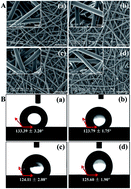Annealing regulates the performance of an electrospun poly(ε-caprolactone) membrane to accommodate tissue engineering†
Abstract
The profound effect of annealing on the electrospun poly(ε-caprolactone) scaffold is comprehensively investigated for the first time. Interestingly, after annealing at 42 °C, the contact angle of the sample decreases from (133.39 ± 3.20) to (124.11 ± 2.08)°, meanwhile the Young's modulus dramatically increases from 8.41 ± 1.64 to 11.27 ± 2.41 MPa, which is attributed to the improved crystallinity. The above results and additional excellent cellular proliferation demonstrate that the annealed matrix possesses better physical and biological performances as a tissue engineering scaffold.


 Please wait while we load your content...
Please wait while we load your content...